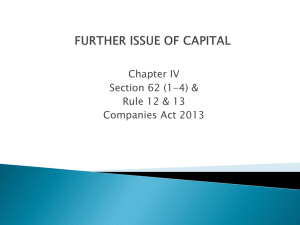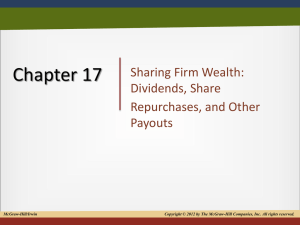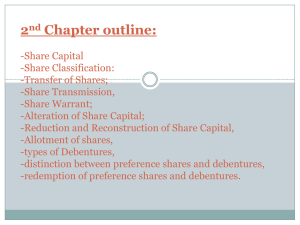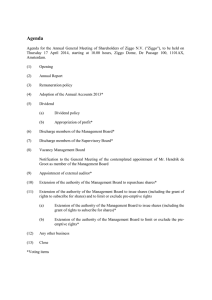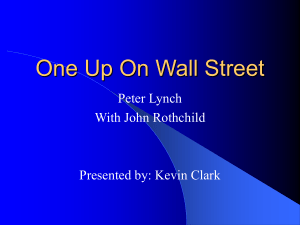Stock split - Michigan Stock Market Game Coordinator
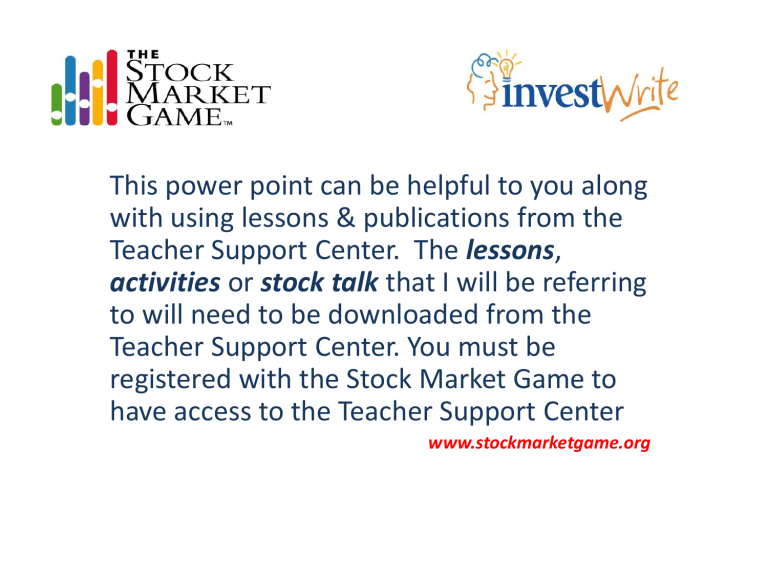
This power point can be helpful to you along with using lessons & publications from the
Teacher Support Center. The lessons,
activities or stock talk that I will be referring to will need to be downloaded from the
Teacher Support Center. You must be registered with the Stock Market Game to have access to the Teacher Support Center www.stockmarketgame.org
How to find Lessons Sequence
• Begin by logging on to the Stock Market Game ( www.stockmarketgame.org
)
• Scroll down In the Classroom & click on Lesson Sequence
• Click on “Display a Complete Outline of All lessons” & click Display Report
Lessons for elementary, middle and high school for the following topics;
The Stock Market Game Bonds
InvestWrite Mutual Funds
Company P/E Ratio
Stock Margin
Ticker Symbols/Stock Quotes Cause for Stock Price Change
Risk Buy, Sell or Hold
Growing Investments Corporate Actions
Dividends & Earnings Indexes
Markets Short Selling
Securities Industry Investment Strategy
Diversification Investor Protection
How to Find Publications
• Scroll down In the Classroom & click on Publications
• Click on Next
You will now have access to all publications including the following;
• Beewise: saving and investing
• Beyond the Market: 14 lessons about investing and the stock market.
• In the News: newsletter correlating current events to investing and the stock market.
• Learning from the Market: integrates skills taught through the SMG across several subject areas.
• Math Behind the Market: reinforces mathematical concepts using the SMG.
• Stock Talk: this newsletter promotes an understanding of investment and stock market terms through demonstration in a fictional setting.
Basic Rules
of
the SMG
1. All Trades will be charged a 2% broker fee. This broker fee is included in the price of the stock. For example: You buy a stock priced at $10.00. Now let’s include the broker fee. 10 x 0.02 = $0.20 (10.00 + 0.20
= $10.20.
Remember when buying a stock such as Apple (aapl) which is trading at $573.00 will have a broker fee of (573 x .02 = $11.46) $11.46
3. Students must buy at least 100 share per trade.
4. Stocks must be over $5.00
You can learn more by logging on at www.stockmarketgame.org
. Scroll down Understanding the SMG & click on Rules of the Game.
Making a Trade – After the student logs on to the SMG click on Enter a Trade. Choose stock, mutual fund or bond. When choosing a stock – click buy or sell (when selling a stock). Enter company ticker symbol. Enter number of shares and click Preview trade. Read over the information of your trade and if it looks ok, enter your password and click Confirm Trade.
Finding your Rankings: Log on to the stock market game. If you look in the lower left hand corner, you will see the link for rankings. Click on Rankings. You have two choices. Region: ( this is broken down by elementary, middle & H.S) Coordinator : (this is the entire state rankings for your game session)
Table of Contents
pages 6 - 42
Pages in bold are a activities
Pg. 6 Journey/stock Pg. 20 answer key Pg. 34 answer key
Pg. 7 Journey/stock
Pg. 8 History
Pg. 21 Risk tolerance
Pg. 22 answer key
Pg. 35 P/E Ratio
Pg. 36 Buying on Margin
Pg. 9 What are stocks
Pg. 10 Logos
Pg. 11 stock/vocab
Pg. 12 stock assessment
Pg. 13 answer key
Pg. 14 stock calculations
Pg. 15 answer key
Pg. 16 vocab activity
Pg. 17 answer key
Pg. 18 Risk
Pg. 19 How much risk?
Pg. 23 Dividends/Earnings
Pg. 24 Dividends/Earnings
Pg. 25 Dividends/Earnings
Pg. 26 Dividends/Earnings
Pg. 27 answer key
Pg. 28 Diversification
Pg. 29 Diversification
Pg. 30 How much Diversified
Pg. 31 answer key
Pg. 32 Divers. algebra
Pg. 33 Divers. algebra
Pg. 37 EPS
Pg. 38 Stock Splits
Pg. 39 Stock Splits
Pg. 40 Short Selling
Pg. 41 Short Selling
Pg. 42 Beta
Journey of a SMG stock trade
• The stock price is a"15 minute delay" - student will get the price 5 to 15 minutes after trade time.
• Add 2% broker fee to the stock price - this will be added after the 15 minute delay.
• All transactions will appear in the portfolio after the next opening bell (9:30am)
• However, if the trade was made after 4:00pm the trade will not be entered into the portfolio until after the next business day.
• For example: Johnny buys apple tonight (Tuesday February 22, 2011) after dinner. He will receive tomorrows (9:30am) price and the trade will not show until Thursday, February 24,
2011
• Hot Tip: Transaction Notes is the first place to look when a trade your team entered does not appear in the Account Holdings after 24 hours. Any errors or problems with the trade will be explained here in the Description column
• Check the description column to find out if the stock was executed or not.
• If not there will be a reason some reason are: NEXT PAGE
Journey of a SMG stock trade, CONTINUED
• Cannot Buy a Stock Below $5.00 (You attempted to buy a stock or mutual fund that was trading for less than
$5.00 per share. This is not allowed in the SMG.)
• Executed (A trade you entered was accepted.)
• Exceeds max % for eq (Your state Coordinator has set a maximum % of equity you can have in any one security and the trade you entered exceeds this maximum-See Hot Tip at the bottom of this page for more information.)
• NO connection to portfolio server (System was unavailable for trading. Try again later.)
• Not enough position for transaction (You are trying to enter a transaction to sell or short cover more of a security than you currently hold in your portfolio.)
• Order Canceled (You canceled the trade before the close of market, while it was still in Pending Transactions.
Note: this only applies to teams in end-of-day regions.)
• Order Price is Away From Market (You entered a limit price that was not met.)
• Possible problem with order (You will get this message if a system error occurred during processing. If you get this message, check Account Holdings the day after you entered the trade to see if it has been processed. If not, re-enter the trade.)
• Rejected - Invalid quantity (You entered an invalid quantity for the number of shares.)
• Rejected - Margin exceeded by: $x,xxx (You did not have enough money for the trade, even if you borrowed the maximum-the exact amount will be shown.)
• Rejected - Security Not On File - S04COPF (You have entered a symbol for a security that is not in the database.
Please check the ticker to be sure it was not entered incorrectly. Remember to check the list of securities that have been blocked from trading. There are a variety of reasons SMG teams cannot purchase certain securities.)
• Rejected - Trading is no longer allowed for this security (You have entered a symbol for a security that is no longer trading. If you get this message and find the security is still trading, please have your advisor contact your state Coordinator.)
• Symbol price is zero (You have either entered an incorrect ticker symbol or the system price data feed is not pricing the security. If the ticker symbol is correct, have your advisor notify your state Coordinator.)
History of the Stock Market
•
On May 17, 1792, twenty-four stockbrokers gathered outside 68 Wall Street under a buttonwood tree to sign an agreement that would establish the rules for buying and selling bonds and shares of companies. The Buttonwood Agreement, as it is known, is so named because the tree served as the regular meeting place for these pioneers of Wall Street. The signers of the Buttonwood
Agreement drafted their first constitution on March 8 th , 1817, and named their nascent organization the New York Stock &
Exchange Board.
•
In 1863, this name was shortened to its modern form , the New York Stock Exchange, which became known as the NYSE, one of the best-known financial industry brands in the world. Membership on the NYSE has been held as a valuable property since
1868. Until the NYSE went both electronic and public in April 2006, the exchange was a membership-only organization. You could only join the NYSE by purchasing existing seats, which were limited to a total of 1,366.
•
Merging with the already publicly-traded Archipelago electronic stock exchange, the new company was called the NYSE Group,
Inc., and the seats of the NYSE translated into shares of stock which are now traded under the ticker symbol NYSE: NYX. In
2008, NYSE Euronext welcomed the historic American Stock Exchange into the world’s largest and most liquid exchange group. Originally called the "curb market" because its brokers traded outdoors in the street, the Amex has been at the forefront of the U.S. financial markets over the course of two centuries.
• As the 20th Century dawned, the NYSE was firmly established as one of America’s preeminent financial institutions. It was also experiencing a sustained rise in trading volume. Trading in listed stocks tripled between 1896 and 1899. It would nearly double again by 1901.
•
More space was clearly needed. So the Exchange invited eight of New York City’s leading architects to join in a competition to design a grand new building. Their instructions: The trading floor was to have more space, more light, and more convenience for the transaction of business. The Exchange chose the neoclassic design of architect George B. Post. The new Exchange building at
18 Broad Street opened on April 22, 1903 to fanfare and festivity. The Exchange building is considered one of Post’s masterpieces and is a national landmark.
www.nyse.com
What are Stocks?
Stocks represent a share of ownership in a publicly held company. The stockholder has a claim on the assets of a company in exchange for the money paid to purchase the stock. As an owner, the stockholder is sharing the wealth AND the risk of ownership with other owners of the company. No matter how few shares of stock you own, you are part owner of the business.
Traditionally, a company decides to issue stock in order to raise money to expand and build their operations. The company goes to a financial services firm that specializes in underwriting an initial public offering (IPO) of stock to help them with this process. The financial firm gives the company the money it needs to expand, and issues the stock. This stock is sold to the public in what is known as the secondary market. Stockholders, sometimes called shareholders, are people who buy the stock.
Stockholders may receive part of the company’s profits through dividends. Public companies are not obligated to pay dividends, but most successful companies do.
People buy stock to earn dividends and with hope of selling the stock at a higher price than they originally paid.
Stockholders have limited liability; that is, while they can lose the money they invested to buy the stock, they are not responsible for the company’s financial debts should the company fail.
A stockholder should make investment decisions based on his/her “risk tolerance.” All investments have some risk, but a somewhat risky investment with great potential to increase in value might be a good for someone who is 28 and financially stable, but not for someone who is 60 and plans on retiring in five years. A 28-year-old has time to regain losses before retirement; the 60-year old may not . “What is a Stock” (Teacher Support Center )
You can buy stock from these well known Companies
What is a Stock
(vocabulary)
• Common Stock: Shares represent ownership in a corporation and give the right to vote for the company's board of directors and benefit from its financial success
• Dividend: Part of a company’s profits (earnings) that is pays as money or shares to stockholders. In The Stock Market Game, any dividends received are listed in Transaction
History and are included in the portfolio’s total equity.
• Earnings: Whatever profits or net income remains after subtracting the company’s expenses from its revenue. A company’s profit.
• Initial Public Offering (IPO): An IPO is the first issue of stock for public trading made by a company.
• Investor: Someone who purchases stocks, bonds, mutual funds and other financial instruments in hopes the investments will increase in value over time.
• Parent Company: A company that owns enough voting stock in another firm to control management and operations.
What is a Stock (middle school)
Activity Sheet 2: What is Stock Assessment?
1 . The government owns the stock market. ________
True or False
2. Only the very rich can buy stock. ________
3. There is only one place you can buy stock in the United States. _______
4. Stockholders can only make money by collecting dividends. _______
5. People who invest in the stock market will always make money. ______
6. People can only buy stock in public companies. _______
7. A dividend is a portion of the company’s profits paid to its stockholders. _______
8. Stock can be purchased by any investor. ______
9. A company issues shares of stock in order to raise funds for expansion. _______
10. The New York Stock Exchange is where all stocks are traded. ______
11. Someone who bought a company’s stock for $16.50 and sold it for $23.50, lost money on the investment.______
12. An investor takes a risk when buying any stock. ______
Activity Sheet 2: What is Stock Assessment? (answer key)
• The government owns the stock market.
False
• 2. Only the very rich can buy stock. False
• 3. There is only one place you can buy stock in the United States. False
• 4. Stockholders can only make money by collecting dividends. False
• 5. People who invest in the stock market will always make money. False
• 6. People can only buy stock in public companies. True
• 7. A dividend is a portion of the company’s profits paid to its stockholders. True
• 8. Stock can be purchased by any investor. True
• 9. A company issues shares of stock in order to raise funds for expansion. True
• 10. The New York Stock Exchange is where all stocks are traded. False
• 11. Someone who bought a company’s stock for $16.50 and sold it for $23.50, lost money on the investment. False
• 12. An investor takes a risk when buying any stock. True
Activity Sheet 3: Stock Market Calculations
• You purchased 100 shares of Nike at $47.75 per share. A year later you sell your 100 shares for $62 per share. Did you make a profit or lose money? How much money did you make or lose? Explain how you calculated your answer.
• You purchase 259 shares of Sonic Corporation for $24.38 per share. What is the total cost of your purchase? You later sell your shares at the current market price of $22.12. Did you make a profit or was this a losing investment? How much money was your profit or loss? Explain how you calculated your answer.
• Shares in Starbucks Coffee sold for $57.12 per share eighteen months ago; you purchased 100 shares.
You just sold your shares at $68.38 per share. How much profit did you make on the sale?
• You own a total of 450 shares in three companies. The number of shares and their current prices are:
175 shares of Gillette—$71.38 per share for shares; 189 shares of General Electric—$34.25 per share; and 86 shares of Hershey Foods— $52.68 per share. What is the value of your portfolio?
• www.stockmarketgame.org
(Teacher Support Center)
Activity Sheet 3: Stock Market Calculations (Answer Key)
1. You made a profit of $ 1,425.00
Bought 100 X 47.75 = $ 4,775.00
Sold 100 X $ 62.00 = $ 6,200.00
$ 6200 (Sold) – $ 4775.00 (Bought) = $ 1,425.00 (Profit)
2. This investment was a loss of $ 585.34
Total price of purchase:
Bought 259 X $ 24.38 = $ 6,314.42
Sold 259 X $ 22.12 = $ 5,729.08
$ 5,729.08 (Sold) - $ 6,314.42 (Bought) = - $ 585.34
3.
You made a profit of $ 1,425.00
Bought 100 X $ 57.12 = $ 5,712.00
Sold 100 X $ 68.38 = $ 6,838.00
$ 6,838.00 (Sold) - $ 5,712.00 (Bought) = $ 1,126.00
4. 175 shares Gillette X $ 71.38 = $ 12,491.50
189 shares General Electric X $34.25 = $ 6,473.25
86 share Hershey Foods X 52.68 = $ 4,530.48
$ 12,491.50 + $ 6,473.25 + $ 4,530.48 = $ 23,495.23
Activity Sheet 4: Speaking of Stocks
_________________________ represents shares of ownership in a company.
Only ______________________ traded companies are able to sell ownership in their companies through a large market place known as a________________________.
People who own shares of a company are called______________________.
Some companies are owned by families or a small number of investors and do not issue stock to the public.
These companies are known as ________________held companies.
Owning stock in a company is one way you can _____________________ your money; you could also
_______________in mutual funds or real estate.
A ________________________ is part of the company’s ____________ that the board of directors decides to distribute to the_____________________.
If a stockholder sells his/her shares for less than he or she paid for them, the stockholder has experienced a
_____________________.
Stock Dividend Invest Stock Market Public
Stockholders Profit Loss Private
Activity Sheet 4: Speaking of Stocks (answer key)
• Stock represents shares of ownership in a company.
• Only publicly traded companies are able to sell ownership in their companies through a large market place known as a stock market.
• People who own shares of a company are called shareholders.
• Some companies are owned by families or a small number of investors and do not issue stock to the public. These companies are known as private held companies.
• Owning stock in a company is one way you can invest your money; you could also invest in mutual funds or real estate.
• A dividend is part of the company’s profit that the board of directors decides to distribute to the
stockholders.
• If a stockholder sells his/her shares for less than he or she paid for them, the stockholder has experienced a loss.
What is Risk?
• Risk is defined as the “exposure to a chance of loss.” Each investor must decide what level of risk is acceptable to them. This is called “risk tolerance.” Once a person’s level of risk tolerance is understood, they can build their portfolios to match their risk level. Most investments fall into three categories:
• Conservative—Investment-grade bonds and preferred stocks are considered conservative.
• Moderate—Include growth stocks, which are stocks that pay little or no dividends because the company is investing all of its earnings in its rapid growth, particularly young companies with great potential.
• Speculative—Stock investments are volatile and can lead to large profits or severe losses.
• Vocabulary
• Risk: The chance of losing all or part of the value of an investment.
• Risk Tolerance: An individual investor’s ability to accept loss of some or all of the money they have invested. A person’s risk tolerance is based on a number of factors including age, financial stability, amount of time before the invested funds are needed for other purposes, etc.
• Volatility: Indicates how much and how quickly the value of an investment, market, or market sector changes
Activity Sheet 2: How Much Risk Can You Stand
• As we’ve learned, risk is a personal thing. Based on factors such as age, salary, financial obligations, and family situation, people’s risk tolerances vary greatly.
• Below are descriptions of individuals who are thinking about investing in the Stock Market. What do you think is the risk tolerance of each one?
L=low; M=moderate; H=high
• Teddy is 26 and has just gotten a new job at a much higher salary. He is single, has no loans and will get a raise within six months. He wants to invest some of his newfound wealth. His risk tolerance is __________.
• Juanita is a single mother with two children, ages 10 and 12. She wants them to go to college and is putting aside money to help pay for their educations. It will be six years before she needs money to help her first child with college. Her risk tolerance is __________.
• Bill is 62. His health is good. His wife has a low paying job, but their children are grown and off on their own. Bill and his wife will retire in three years. Bill’s risk tolerance is__________.
• Tasha is 8. Her mother and father want to start a small investment portfolio for her to use for college or to help buy a home someday. Tasha’s risk tolerance is _____________.
• Monique and Harrison are in their forties and have three children. They have a mortgage and some credit card bills, but they have put aside a small amount of money to invest for retirement. They hope to retire when they are 65. Their risk tolerance is ____________.
Activity Sheet 2: How Much Risk Can You Stand (answer key)
His risk tolerance is H.
Her risk tolerance is L.
Bill’s risk tolerance is L.
Tasha’s risk tolerance is H.
Their risk tolerance is M www.stockmarketgame.org
Conservative, Moderate or Speculative?
• Directions: Decide if the following investments are conservative, moderate or speculative.
Investment 1: Jax Company provides gas and electric to your area. Its stock has risen slowly and steadily over the last two years. It pays an annual dividend of $4 per share per year. You own 200 shares, so the company pays you a yearly dividend of $800. What type of risk are you taking by investing in Jax Company? Explain
Investment 2: Watching the news, you learn a new drug is coming out that supposedly makes children smarter. You’ve never heard of the drug manufacturer, but you decide to invest in this company. Why wouldn’t we want our children smarter? If you have no other information and plan to invest in this drug company, what kind of risk are you taking? Explain.
Investment 3: Interior Electric announces it is creating an all-electric car, but it hasn’t come out yet. Based on the news, its stock price has increased 20% in one month. If you buy the stock now, what type of risk are you taking? Explain
Conservative, Moderate or Speculative? (answer key)
• Investment 1: Low: Utilities are considered lower risk stocks. The current dividend provides steady gain on the investment. The company has been growing steadily in the past couple of years and seems to be stable.
• Investment 2: Without other information this would be a higher risk stock purchase. There is no way to tell what kind of side affects the drug would have because there is no information on whether the drug has been tested and there could be seriously harmful effects to the children who are given the drug. The company doesn’t appear to have a strong, good reputation as a drug manufacturer because you have never heard of them. The reliability of the company and the product haven’t been proven so an investment would be risky.
• Investment 3: This is a moderately risky stock. The product would probably sell very well if successful but there is a lot of research and testing to be done so the company would be putting a lot of it’s profit back into research and development for awhile
Dividends & Earnings
•
Dividends: Part of a company’s profits (earnings) that is pays as money or shares to stockholders. In The Stock Market Game, any dividends received are listed in Transaction
History and are included in the portfolio’s total equity.
• Distribution date: Date on which the dividend payment ismade.
• Profit: What remains after subtracting a company’s costs from its revenue. Profit is a company’s reward for taking a risk and successfully producing what people want to buy at prices they are willing to pay.
• Price/Earnings Ratio: A company’s closing price divided by its latest annual earnings per share. The Price / Earning is the relationship between a company’s earnings and its share price. It is calculated by dividing the current price per share by the earning per share.
• Record Date: Date set by a company on which an individual must own shares to be eligible to receive dividends.
• Stock split: Replacing each share of stock with a larger number of lower-priced shares. A stock split keeps the shareholders’ total investment value unchanged.
• Yield: The rate of return on an investment paid in dividends or interest. It is expressed as a percent
Dividends & Earnings
• Investors may make money on their investments through dividends and by selling stocks for a profit. This lesson involves a guided reading that examines the ways investors profit from their portfolio, using a newspaper’s daily stock listings and calculating dividends and earnings.
• When a company is doing well, it can do a variety of things with its profits:
• Reinvest the earnings and use the funds for expansion.
• Develop new products.
• Give a percentage of the profits to shareholders through dividends.
• Dividends are generally paid quarterly and are a set dollar amount distributed to every shareholder of record on a certain date. A dividend is allocated per share, so the more shares an investor owns, the larger the dividend payment he/she receives.
• SMG team portfolios are credited automatically with the cash value of dividends earned. If teams sell shares before the record date, they will not earn dividends on that stock. Stocks go ex-
dividend; that is, purchasers who buy the stock on the record date and up to the distribution date do not receive dividends for that quarter.
Dividends & Earnings
• As you begin SMG, it is important that you know all the ways to earn money through investing. The two key ways are: buy stock at a low price and sell shares for a profit and earning dividends from your team’s stock. Smart investors make money in the market by doing both over a long period of time.
• Investors consider two major personal factors in making financial decisions:
• Risk Tolerance - Are they willing to risk their principal investment in the hopes of gaining greater profit? As a rule, the greater the risk the greater potential profit; however, as risk grows, so does the potential for greater loss.
• Stage in Life - Retired people or those close to retirement tend to look for stable investments that pay dividends. An investor who will not need their money for years may take some risk knowing that over time, the stock market tends to do better than other financial investments.
• As you invest, remember that certain factors such as changes in the economy, tax laws, monetary policy, war, unemployment, seasonal buying, national disasters such as hurricanes, the avian flu, or even extended heat waves can impact stock prices.
• In addition to buying low and selling high, you can make money in the market in other ways
When a company is doing well, it has several ways it can use its profits. It can:
• Invest in itself, using profits to expand, develop new products, modernize or make other improvements .
• Give a percentage of its profits to the shareholder through dividends. The company’s board of directors sets a dollar amount per share distributed to every shareholder on a certain date. For example, if you own
100 shares of XYZ Company and the company declares a $2 annual dividend, you will receive $.50 each quarter that you own the stock that year. Dividends change over time.
Dividends & Earnings
• SITUATION 1
• Company A has 4 investors.
• Investor 1 has 100 shares,
• Investor 2 has 150 shares,
• Investor 3 has 500 shares, and
• Investor 4 has 625.
• Company A had a good quarter and decides to pay a quarterly dividend of $3 per share.
Calculate the amount of dividend that will be paid to each investor
• SITUATION 2
• Company B has 2 investors.
• Investor 1 has 1000 shares and
• Investor 2 has 1500 shares.
• Company B had a good year and decides to pay a $1.50 quarterly dividend for each share owned. Calculate the amount of dividends the company will pay to each investor by the end of the year.
Dividends & Earnings
(answer key)
• SITUATION 1
• Investor 1: $300
• Investor 2: $450
• Investor 3: $1,500
• Investor 4: $1,875
• SITUATION 2
• Investor 1: $6,000
• Investor 2: $9,000
For more on Dividends and Earnings log on to: www.stockmarketgame.org
Dividends and Earnings (In The Classroom)
Diversification
• Diversifying investments is a widely used and highly successful way to reduce risk. Most financial planners agree with the admonition “don’t put all your eggs in one basket. By investing in different types of stocks, bonds, and/or mutual funds, the value of your entire portfolio should not be wiped out if one investment fails.
• Because it is very difficult to accurately predict how any one company will perform over time, diversification is a strategy that helps to protect your portfolio.
• The Stock Market Game is a great way for students to learn about diversifying by analyzing the stocks in their portfolio. In this lesson students learn to diversify their SMG portfolios by investing in companies from different industries. Students will use a financial website to complete this lesson.
Diversification
(vocabulary)
• Diversification: an investment strategy in which you spread your investment dollars among different markets, sectors, industries, and securities. The goal of the strategy is to protect the value of your overall portfolio in case a single security or market sector takes a serious downturn and drops in price.
• Index: An index reports changes, usually expressed as a percentage, in a specific financial market, in a number of related markets, or in an economy as a whole. Each index — and there are a large number of them — measures the market or economy it tracks from a specific starting point, which might be as recent as the previous day or many years in the past.
• Industry: A group of companies producing similar products or services.
• Portfolio: A collection of investments owned by one individual or organization.
• Risk: The chance of losing all or part of the value of an investment.
• Risk Tolerance: An individual investor’s ability to accept loss of some or all of the money they have invested. A person’s risk tolerance is based on a number of factors including age, financial stability, amount of time before the invested funds are needed for other purposes, etc.
• Sector: A group of stocks, often in one industry. The performance of any single stock in a sector can be measured against the performance of the group. Pharmaceutical companies, for example, are part of the health care sector.
For more on diversification log on to: www,stockmarketgame.org and go to In the Classroom
Diversification
-
How diversified are these portfolios?
Portfolio A Portfolio B Portfolio C
Symbol /
Quantity
Industry Symbol/
Quantity
Industry Symbol/
Quantity
Industry
FISV (100) Business
TD (100) Software
ADES (100) Bank
TRB (100) Publishing
TW (100) Insurance
ESRX (100) Health
Rail (100) Railroads
JPM (100) Bank
AAPL (150) P.C.
INTC (200) Semi Conductors
GOOG (100) Internet info provider
Ebay (100) Ebay
DELL (300) P.C.
SBUX (500
) Specialty Eateries
TIF (200) Jewelry
BK (100) Banks
GOOG (100) Internet info provider
CSK (100) Paper products
NCC (100) Banks
UNS (700) Electric Utilities
Teacher Support Center –
In the Classroom
Diversification –
How diversified are these portfolios?
(answer key)
All three have some diversification. Portfolio C has a diverse range of companies from different
Industries and is considered to be more diversified.
Diversification – thinking algebraically
• To calculate the percentage of a given investment category in a portfolio, divide the money in that category (for example, all the money invested in small cap firms) by the total amount of money in the portfolio, and multiply by 100%.
% of portfolio invested in a sector = money invested in a sector / total value of investment x 100
Questions for this table are on the next page.
D
E
F
B
C
Company Size
A Small
Large
Small
Mid
Large
Mid
Sector
Tele-comm
Industrial Goods
Health
Energy
Energy
Utilities
Value
$1,500.00
$31,000.00
$15,500.00
$5,000.00
$27,000.00
$19,000.00
Diversification – thinking algebraically
•
What is the total value of the investment portfolio above?
•
Using the portfolio above, calculate the percentage of the total investment in each sector.
•
Using the portfolio above, calculate the percentage of the total investment in each sector.
Diversification – thinking algebraically
(answer key)
1.What is the total value of the investment portfolio above?
Answer: The total value of this portfolio is $99,000.00.
2. Using the portfolio above, calculate the percentage of the total investment in each sector.
Answer: Telecommunications: ($1,500 ÷ $99,000) x 100% = 1.52%
Industrial Goods: ($31,000 ÷ $99,000) x 100% = 31.31%
Health: ($15,500 ÷ $99,000) x 100% = 15.66%
Energy: ($32,000 ÷ $99,000) x 100% = 32.32%
Utilities: ($19,000 ÷ $99,000) x 100% = 19.19%
3. Calculate the percentage of the investment in each size company.
Answer: Small Cap: [($1,500 + $15,500) ÷ $99,000] x 100% = ($17,000 ÷ $99,000) x 100% = 17.17%
Miid Cap: [($5,000 + $19,000) ÷ $99,000] x 100% = ($24,000 ÷ $99,000) x 100% = 24.24%
Large Cap: [($31,000 + $27,000) ÷ $99,000] x 100% = ($58,000 ÷ $99,000) x 100% = 58.59%
Price-to-Earnings ratio P/E
A company’s net earnings are important, of course, since the figure represents how much money a company is making. A company can borrow money when times are lean or if the business needs to expand, but over a sustained period of time, the company must have earnings in order to remain a viable business. As such, earnings represent one of the main numbers to which an investor might pay attention, when analyzing a company’s stock.
One tool for looking at earnings is a company’s P/E ratio (price to earnings ratio). Simply, this P/E figure answers the question “How expensive is this stock in regard to what this company earns? Here’s how the P/E ratio works:
FORMULA: Per share price of stock / Earnings per share (EPS) = P/E ratio (price-to-earnings ratio)
The P/E ratio is important to investors, because the higher the number, the more expensive the stock is in terms of earnings. Most healthy companies whose stock is in good demand will have P/E ratios in the range of perhaps 8 to 22. While there are not hard and fast boundaries, the P/E ratio is one of several factors investors use to gauge a stock’s underlying value.
Example:
The Bunker Hill Shipwrecks and Salvage Claims Corporation had earnings of $1.88 in the previous year and expects the same for the coming year. The price of this stock is $30 per share. What is the company’s P/E ratio?
Answer:
$30 / $1.88 = 15.95
Lessons for P/E ratio can be found in the Teacher Support Center. Once you log in scroll down “In The
Classroom” and click on Lesson Sequence. Click on Show all lessons. Scroll down the list of lessons until you find P/E ratio
Buying on Margin
• Buying on margin
means using the stock in your portfolio as collateral for borrowing money from your broker. The percentage of collateral required in order to finance a purchase or a short sale is called the initial margin requirement. Your broker can lend you up to 50% of the value of the stock being purchased or sold short. However, please remember there is interest charged on this loan. Every week the interest on the money borrowed will be deducted from your portfolio until your loan is paid. Also, to buy on margin, the stock exchanges and most brokerage companies have rules requiring that customers equity must be more than a certain percentage of the value of the stock they own (long and short positions). This percentage is called the Maintenance requirement.
Earnings Per Share (EPS)
The Earnings Per Share (EPS) ratio is one of the most widely used measures of a stock's evaluation. At face value, the EPS ratio is a good measure of the stock, but if you are unaware of its limitations, it can be greatly misleading.
• FORMULA: NET INCOME ÷ TOTAL SHARES OUTSTANDING = EARNINGS PER SHARE (EPS)
The higher the EPS, the better; thus, it might be a good tool to use when evaluating a company. Most investor's veiw EPS as an important tool in evaluating stocks. Most financial papers and journals report the EPS daily. It is also found in the company's annual reports (10-K
& 10-Q).
Stock Splits
• Take, for example, a company with 100 shares of stock priced at $50 per share. The market capitalization is 100 × $50, or $5000. The company splits its stock 2-for-1. There are now 200 shares of stock and each shareholder holds twice as many shares. The price of each share is adjusted to $25. The market capitalization is 200 × $25 = $5000, the same as before the split.
• Ratios of 2-for-1, 3-for-1, and 3-for-2 splits are the most common, but any ratio is possible.
Splits of 4-for-3, 5-for-2, and 5-for-4 are used, though less frequently. Investors will sometimes receive cash payments in lieu of fractional shares
What happens after a stock split?
• It is often claimed that stock splits, in and of themselves, lead to higher stock prices; research, however, does not bear this out. What is true is that stock splits are usually initiated after a large run up in share price. Momentum investing would suggest that such a trend would continue regardless of the stock split. In any case, stock splits do increase the liquidity of a stock; there are more buyers and sellers for 10 shares at $10 than 1 share at $100. Some companies have the opposite strategy: by refusing to split the stock and keeping the price high, they reduce trading volume and volatility. Berkshire Hathaway is a notable example of this.
• Other effects could be psychological. If many investors believe that a stock split will result in an increased share price and purchase the stock the share price will tend to increase. Others contend that the management of a company, by initiating a stock split, is implicitly signaling its confidence in the future prospects of the company.
Short Selling
Short selling is the reverse of the investment process. First, you sell and then you buy the stock back later. To do this you borrow stock from a brokerage firm to sell on the market. You do this because you are hoping to buy it back at a lower price and return the original borrowed stock to the brokerage firm and earn a profit. The act of purchasing stock that has been borrowed and sold is called a short cover. Short selling is one of the ways investors make money, particularly in a bear market .
The following is a simple outline of how short selling works:
1 . Borrow shares of stock from your broker. There is a difference between buying shares and borrowing shares. When you buy shares they are yours to keep. When you borrow shares you must return them upon demand.
2. Sell the shares you borrowed.
3. Wait for the price of the stocks you borrowed to drop.
4. Buy back the same number of shares of stock you borrowed. If the stock price rises instead of drops you will have to spend more money to get the stocks back. You only make a profit when you
can buy them back cheaper than you sold them. There are risks to consider if you short sell. Because the stock you sold was borrowed, it must eventually be returned to the lender. If the stock’s price has dropped, you make a profit because you are able to buy it back for less than what you borrowed it for. If the stock’s price increases, you will lose money because you will have to pay more than what you originally sold the stock for. When you invest your money buying shares of stock, you can
Short Selling, continued
• only lose what you paid for the stock. However, when you short sell stock, the amount you can lose is limitless because a stock’s price can rise indefinitely. A short seller should know that as the price of a stock rises, the current margin drops, thereby reducing the current equity. A margin call will be made if the maintenance requirement is not met. A maintenance requirement is a rule that a stock holder’s equity must not fall below a certain percentage. The Stock Market Game’s maintenance requirement is
30%.
To learn more about short selling or to download activities for short selling:
• log on to the Stock Market Game ( www.stockmarketgame.org
)
• Scroll down In the Classroom & click on Lesson Sequence
• Click on “Display a Complete Outline of All lessons” & click Display Report
• Scroll down the page to find Short Selling
Beta
A measure of the volatility, or systematic risk, of a security or a portfolio in comparison to the market as a whole. Beta is used in the capital asset pricing model (CAPM), a model that calculates the expected return of an asset based on its beta and expected market returns.
Beta is calculated using regression analysis, and you can think of beta as the tendency of a security's returns to respond to swings in the market. A beta of 1 indicates that the security's price will move with the market. A beta of less than 1 means that the security will be less volatile than the market. A beta of greater than 1 indicates that the security's price will be more volatile than the market. For example, if a stock's beta is 1.2, it's theoretically 20% more volatile than the market.
Many utilities stocks have a beta of less than 1. Conversely, most high-tech Nasdaq-based stocks have a beta of greater than 1, offering the possibility of a higher rate of return, but also posing more risk.
Source: www.investopedia.com


